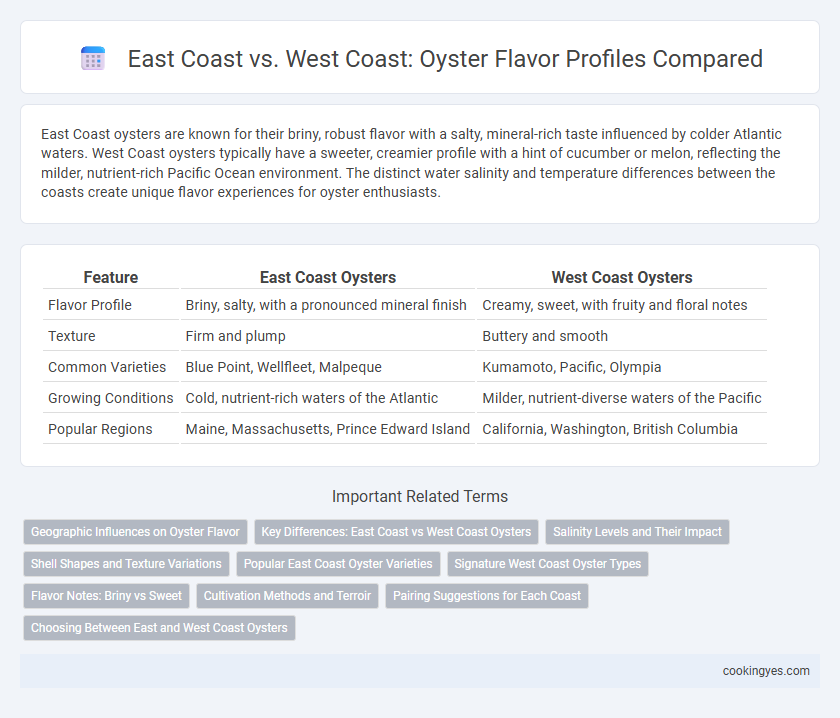East Coast oysters are known for their briny, robust flavor with a salty, mineral-rich taste influenced by colder Atlantic waters. West Coast oysters typically have a sweeter, creamier profile with a hint of cucumber or melon, reflecting the milder, nutrient-rich Pacific Ocean environment. The distinct water salinity and temperature differences between the coasts create unique flavor experiences for oyster enthusiasts.
Table of Comparison
| Feature | East Coast Oysters | West Coast Oysters |
|---|---|---|
| Flavor Profile | Briny, salty, with a pronounced mineral finish | Creamy, sweet, with fruity and floral notes |
| Texture | Firm and plump | Buttery and smooth |
| Common Varieties | Blue Point, Wellfleet, Malpeque | Kumamoto, Pacific, Olympia |
| Growing Conditions | Cold, nutrient-rich waters of the Atlantic | Milder, nutrient-diverse waters of the Pacific |
| Popular Regions | Maine, Massachusetts, Prince Edward Island | California, Washington, British Columbia |
Geographic Influences on Oyster Flavor
Oyster flavor profiles on the East Coast are defined by colder Atlantic waters, resulting in a briny, crisp taste with a clean, mineral finish, often influenced by estuarine environments rich in plankton. West Coast oysters, cultivated in the Pacific's diverse coastal ecosystems, typically exhibit a sweeter, more buttery, and fruitier flavor due to warmer waters and tidal variations. Geographic elements like salinity, temperature, and sediment composition play crucial roles in shaping the unique taste characteristics of oysters from each coast.
Key Differences: East Coast vs West Coast Oysters
East Coast oysters are known for their briny, salty flavor with a firm texture, often influenced by cooler, nutrient-rich waters of the Atlantic Ocean. West Coast oysters offer a sweeter, more buttery taste with a creamier texture, shaped by the milder, less salty Pacific Ocean environment. The key differences stem from the distinct water salinity, temperature, and mineral content, which directly impact oyster flavor profiles and texture.
Salinity Levels and Their Impact
East Coast oysters typically exhibit higher salinity levels due to the Atlantic Ocean's salt content, resulting in a brinier, more robust flavor that highlights marine mineral notes. West Coast oysters, influenced by the Pacific Ocean's varied estuarine environments, generally have lower salinity, lending to a sweeter, more buttery taste profile. These salinity differences significantly impact the oyster's texture and aftertaste, with East Coast varieties often offering a sharper finish compared to the smoother, creamier West Coast specimens.
Shell Shapes and Texture Variations
East Coast oysters typically have a deeper cup-shaped shell with a rougher texture, contributing to their briny, robust flavor and firmer, meatier texture. West Coast oysters feature flatter, more elongated shells with smoother surfaces, offering a sweeter, creamier taste and a softer, silkier mouthfeel. These shell shape and texture variations are influenced by regional water salinity and tidal patterns, directly impacting oyster flavor profiles and culinary uses.
Popular East Coast Oyster Varieties
Popular East Coast oyster varieties like Blue Point, Wellfleet, and Malpeque offer bold, briny flavors with a crisp, clean finish, reflecting the cold, nutrient-rich Atlantic waters. These oysters typically feature a balanced mix of saline and mineral notes, with subtle sweetness and a firm, meaty texture prized by connoisseurs. Compared to West Coast oysters, East Coast varieties emphasize a more pronounced brininess and a complex, mineral-driven taste profile that highlights their unique coastal terroir.
Signature West Coast Oyster Types
Signature West Coast oysters, such as the Kumamoto, Pacific, and Olympia varieties, are known for their clean, briny, and mildly sweet flavor profiles with a buttery texture. These oysters typically exhibit a subtle mineral finish, reflecting the cool, nutrient-rich waters of the Pacific Northwest. Compared to East Coast oysters, which tend to be saltier and more robust, West Coast oysters offer a delicate balance of sweetness and umami that appeals to refined palates.
Flavor Notes: Briny vs Sweet
East Coast oysters are known for their pronounced briny flavor, reflecting the saltier, cooler Atlantic waters, with notes of seaweed and a crisp, mineral finish. West Coast oysters tend to have a sweeter, creamier taste, influenced by the warmer Pacific waters and a slightly fruitier undertone. These distinct flavor profiles make East Coast oysters ideal for those who prefer a bold, savory bite, while West Coast varieties cater to palates seeking a delicate, smooth sweetness.
Cultivation Methods and Terroir
East Coast oysters exhibit briny, robust flavors influenced by colder waters and estuarine cultivation methods that enhance natural salinity and mineral content. West Coast oysters, grown in cleaner, nutrient-rich coastal currents with extensive intertidal farming practices, tend to offer a sweeter, creamier profile with subtle vegetal notes. Differences in terroir, such as water temperature, salinity, and sediment composition, profoundly shape the distinctive taste characteristics between these regional oysters.
Pairing Suggestions for Each Coast
East Coast oysters, known for their briny, salty flavor with a crisp finish, pair exceptionally well with mignonette sauce, crisp white wines like Sauvignon Blanc, or a squeeze of fresh lemon to enhance their natural ocean taste. West Coast oysters, which tend to have a sweeter, buttery texture with a hint of melon, complement richer accompaniments such as creamy horseradish, tangy cocktail sauce, and fuller-bodied Chardonnay or IPA beers to balance their subtle sweetness. Serving East Coast oysters chilled with light, acidic pairings highlights their brightness, while West Coast varieties benefit from richer, rounder flavors that accentuate their smoothness.
Choosing Between East and West Coast Oysters
East Coast oysters, such as Blue Points and Wellfleets, typically offer a briny flavor with a crisp, clean finish and a slightly salty tang, reflecting the colder, nutrient-rich Atlantic waters. West Coast oysters, including varieties like Kumamotos and Pacifics, often exhibit a sweeter, creamier profile with melon and cucumber notes, influenced by the Pacific's warmer, less saline environments. Selecting between East and West Coast oysters depends on personal taste preferences for either a bold, salt-forward bite or a delicate, sweet experience.
East Coast vs West Coast for oyster flavor profiles Infographic

 cookingyes.com
cookingyes.com